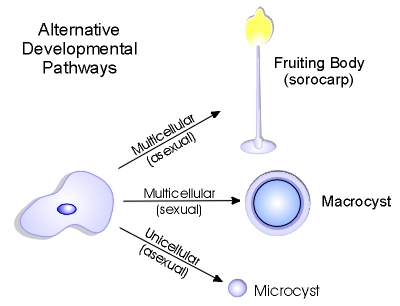The cellular slime moulds are a group of soil microbes with a phenomenal number of attributes that make them excellent "model organisms" for research and teaching. Now that the genome of Dictyostelium discoideum has been sequenced and this organism is recognized as a true model system for biomedical research, the cellular slime moulds continue to gain attention. But there are more cellular slime moulds than just Dictyostelium discoideum and each of them has unique qualities. This site offers some basic insight into the alternative lifestyles of the CSMs. It focuses in on past and present research done in Professor Dan O'Day's laboratory. It is designed to appeal to students, teachers and researchers. If you have any suggestions for improvement or otherwise please let us know.
The first thing that we should address is that while Dictyostelium discoideum has only two alternative life cycles, asexual fruiting body and sexual macrocyst formation many other species have a third asexual cycle, the microcyst cycle. Essentially all fundamental cellular events can be studied by selecting the appropriate stage of one or more of the alternative developmental pathways.

You can access each of these alternative pathways from my homepage or by clicking on each term below.
Last Updated: